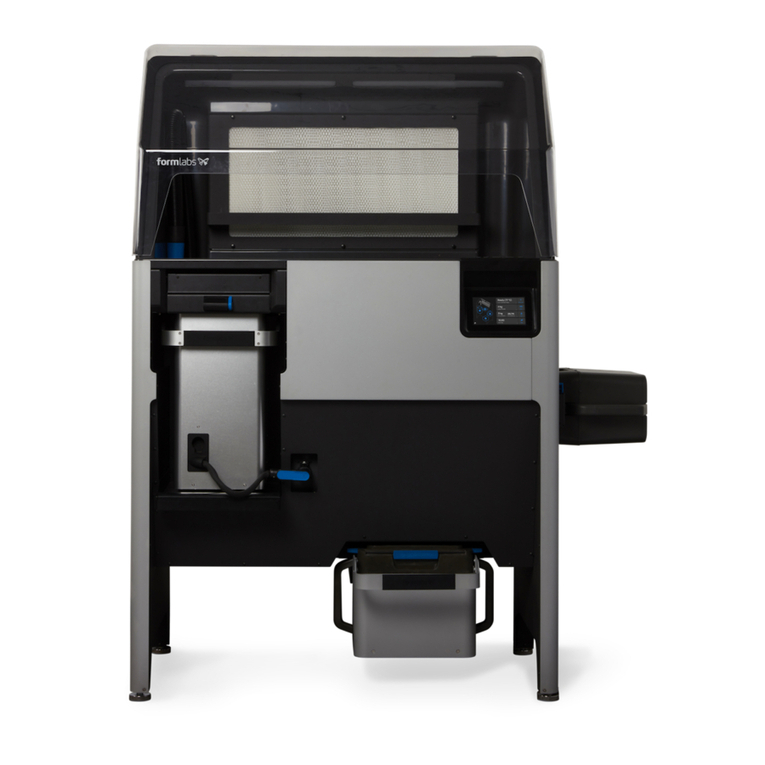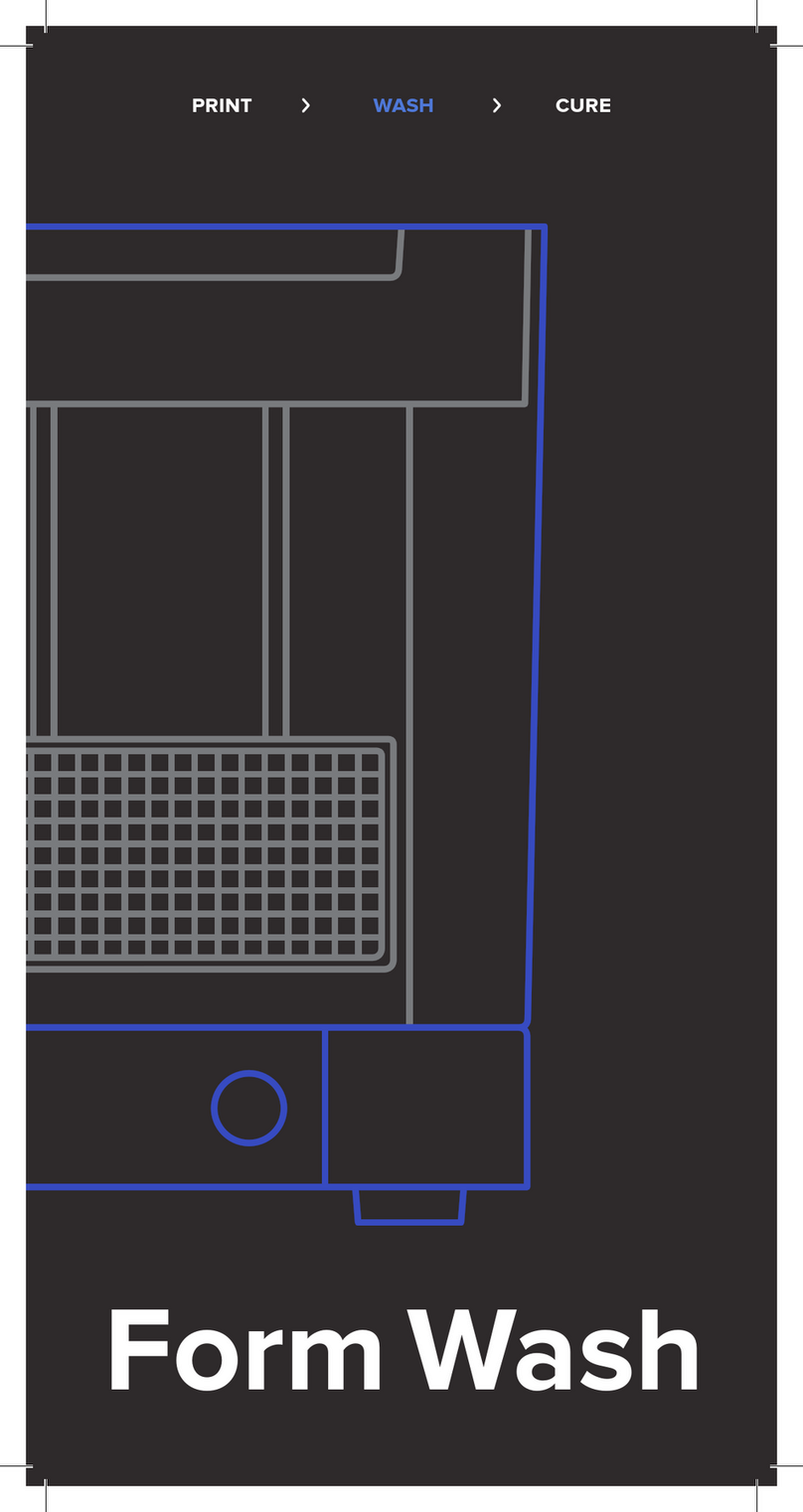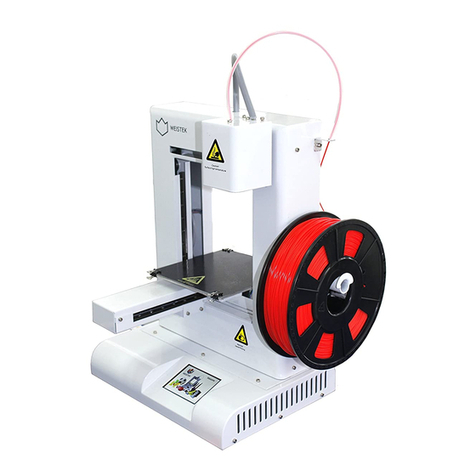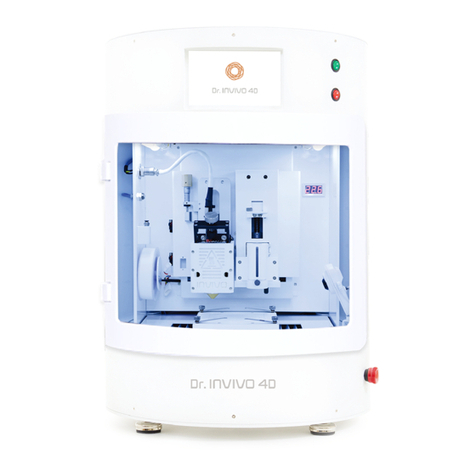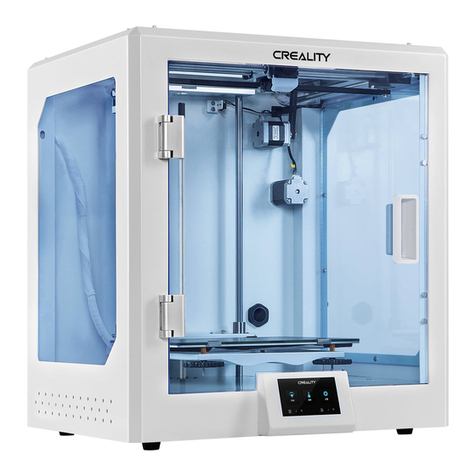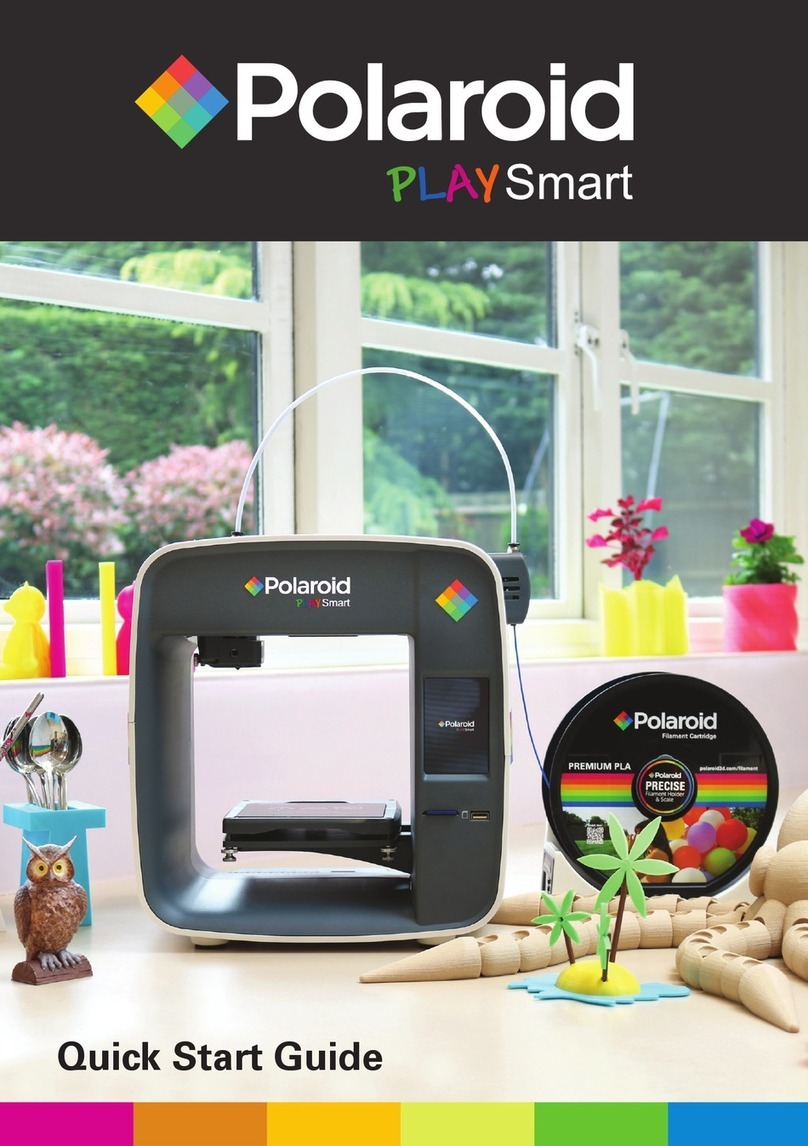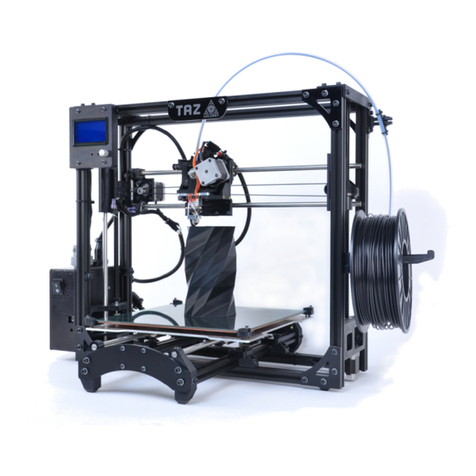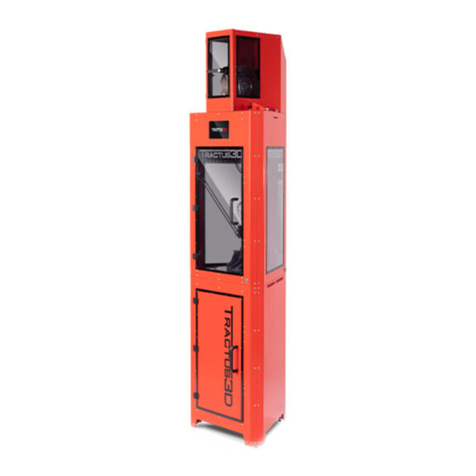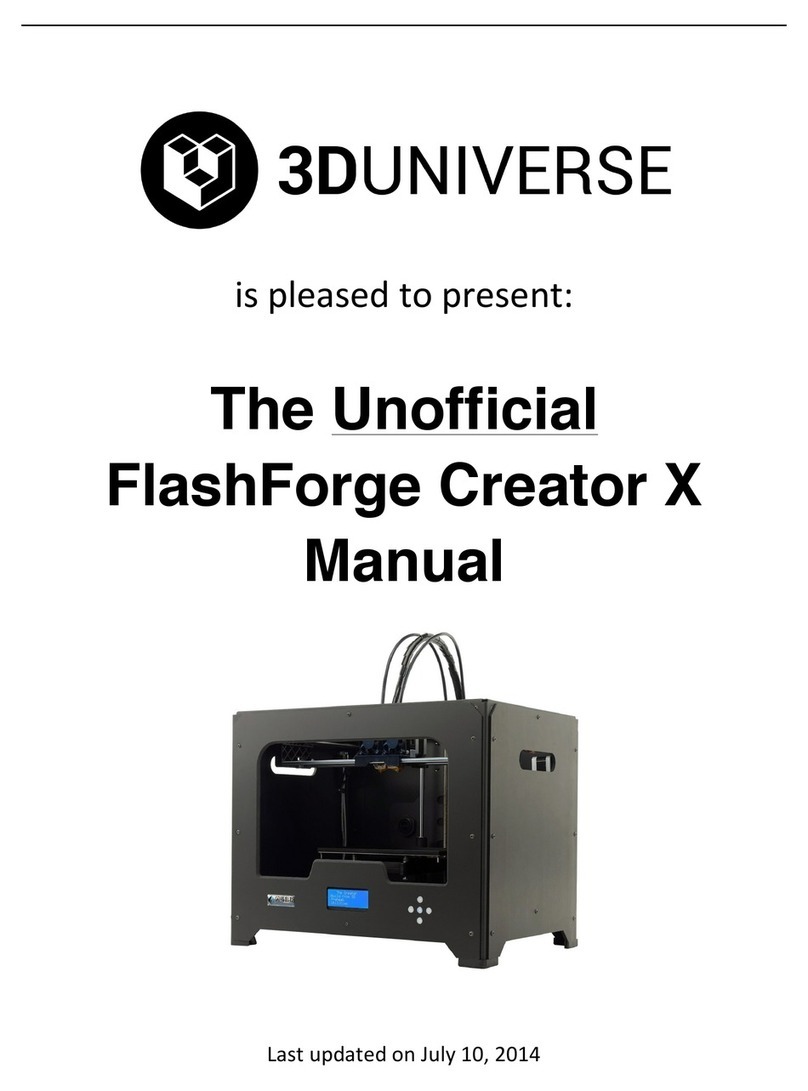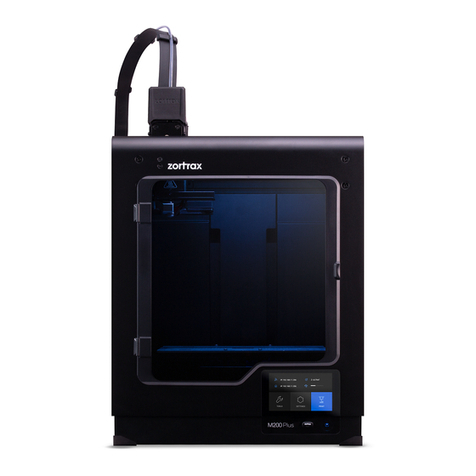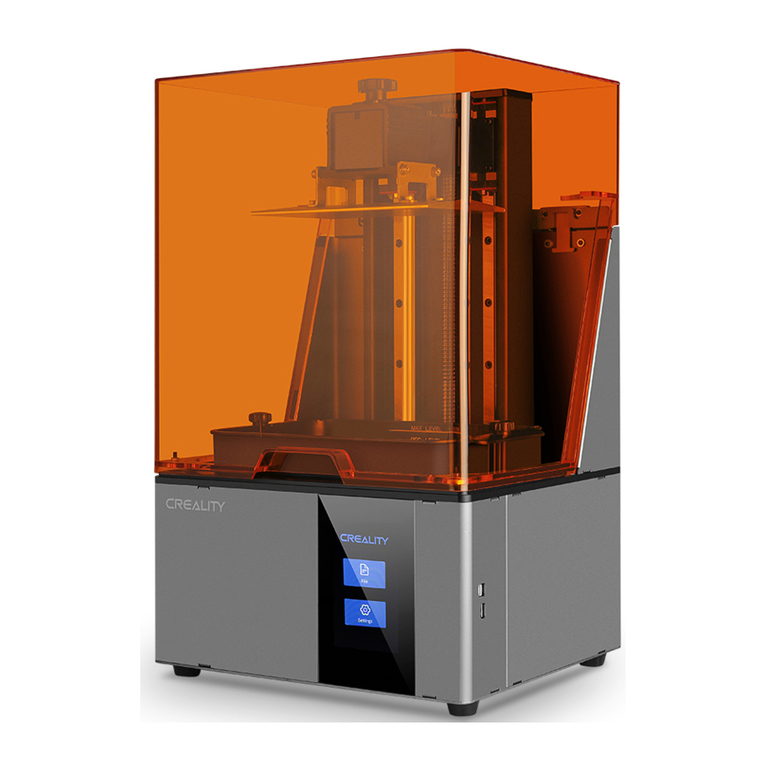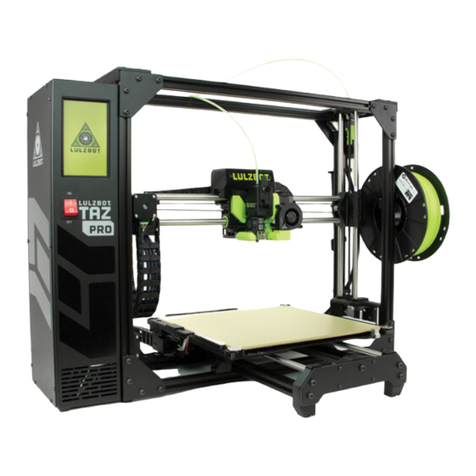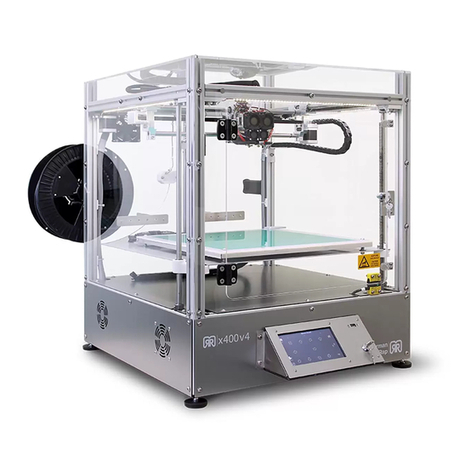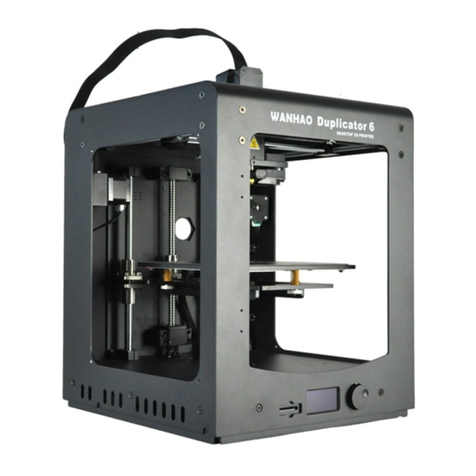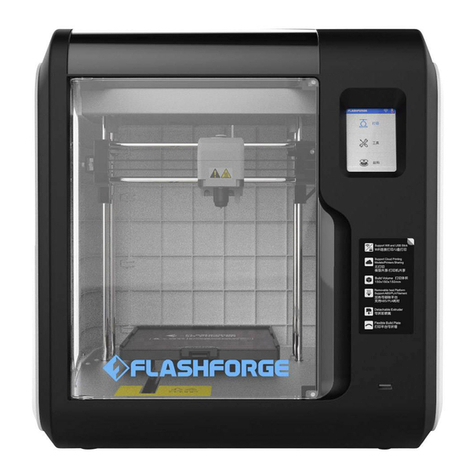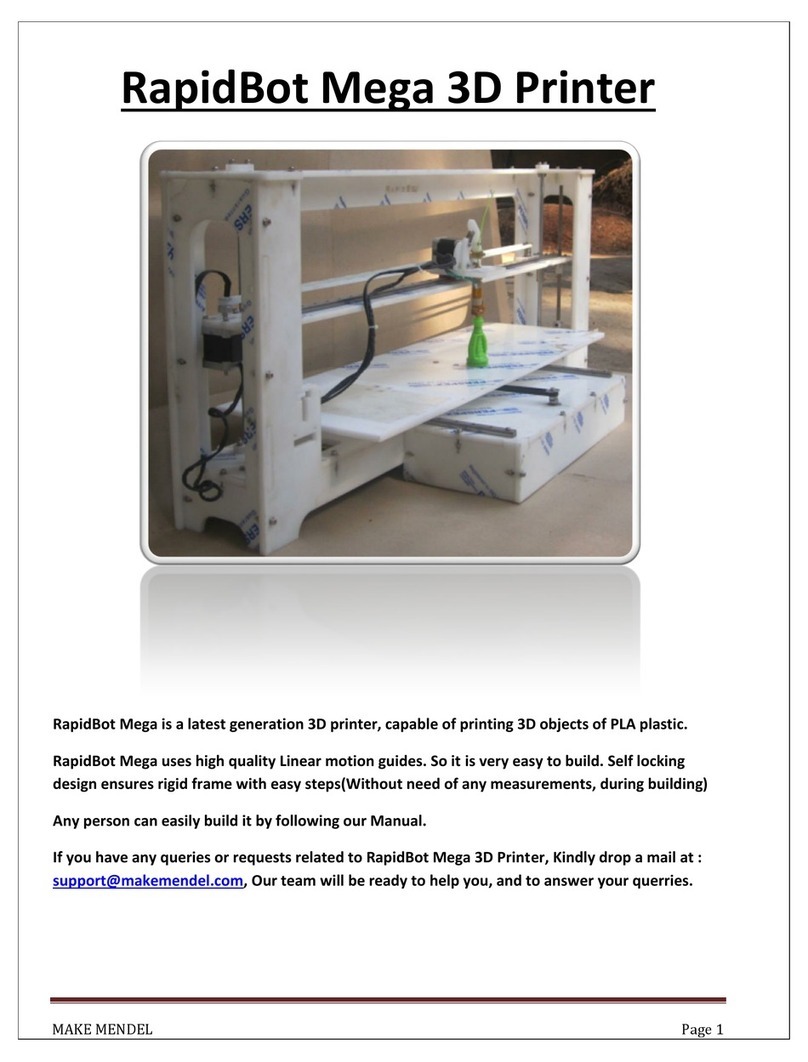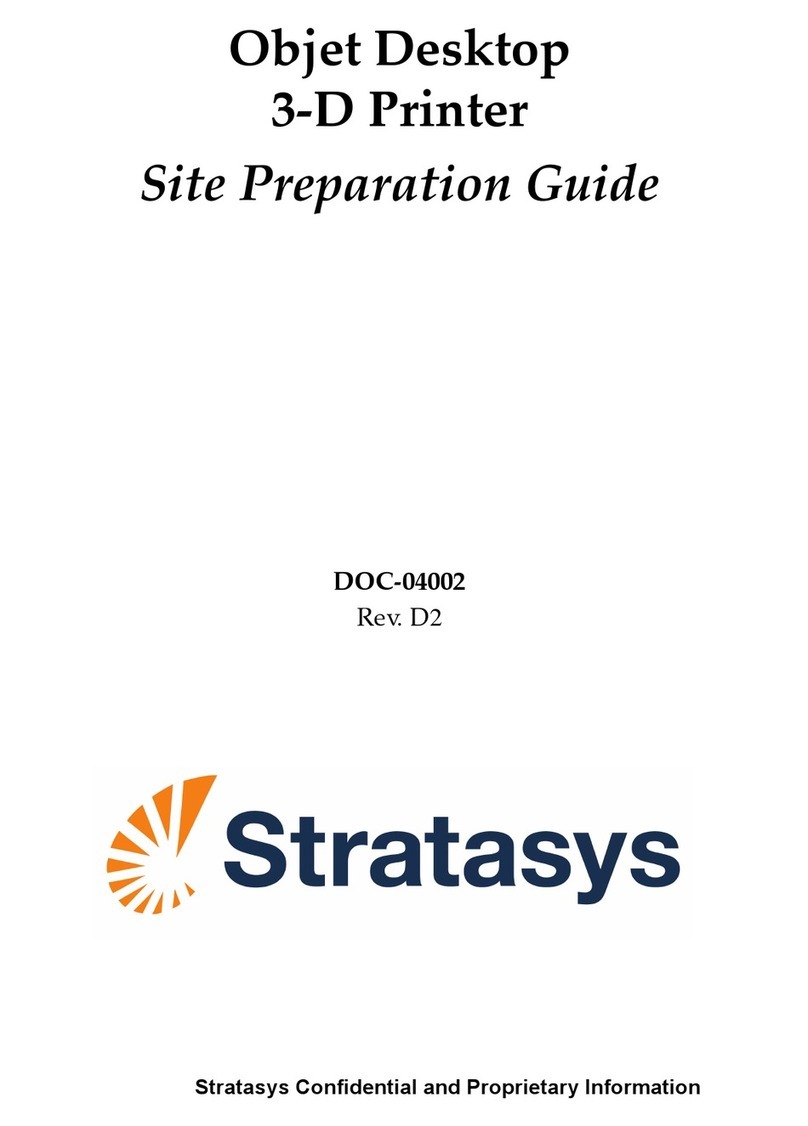formlabs Form 2 Setup guide

Installation and Usage Instructions
Form 2
Desktop Stereolithography 3D Printer

Installation and Usage Instructions
Form 2
Desktop Stereolithography 3D Printer
Original English instructions
Please read this manual carefully and keep it for future reference.
November 2018
REV 02
© Formlabs
1801099-IU-ENUS-0

1. Table of Contents
1. Preface................................................................1
1.1 Read and Retain Instructions.............................................1
1.2 Obtaining Documentation and Information ................................1
2. Introduction ...........................................................3
2.1 Intended Use ..........................................................3
2.2 Technical Data .........................................................4
2.3 Product Elements.......................................................5
2.4 Understanding the Touchscreen .........................................5
3. Safety Warnings .......................................................6
3.1 Component and Subsystem Safety .......................................6
3.2 Personal Protective Equipment (PPE) .....................................8
3.3 Specifications of Tools to be Used........................................8
4. Preparation and Set Up ................................................9
4.1 Installing the Form 2 ....................................................9
4.2 Unboxing the Form2 ...................................................9
4.3 Installing the Form 2 ....................................................9
4.4 Connecting the Form 2.................................................12
4.5 Transporting the Form 2 ................................................13
5. Using the Form 2 .....................................................15
5.1 Operational Environment ...............................................15
5.2 Printing ...............................................................15
5.3 Finishing..............................................................16
5.4 Device Management ...................................................17
5.5 Emergency and Exceptional Situations...................................18
6. Maintaining the Form 2 ..............................................20
6.1 Inspecting the Product ................................................ 20
6.2 Planned Maintenance Procedures.......................................21
6.3 Inspection Tasks Between Prints ....................................... 26
6.4 Monthly Inspection and Maintenance Tasks ..............................27
7. Troubleshooting and Repair .......................................... 30
7.1 Performing a Factory Reset ............................................ 30
7.2 Collecting Diagnostic Logs ............................................ 30
7.3 Cleaning After a Failed Print ............................................31
7.4 Troubleshooting and Repair by Non-Skilled Persons...................... 32
7.5 Troubleshooting and Repair by Skilled Persons .......................... 36
8. Disposal............................................................. 37
8.1 Disassembly ..........................................................37
8.2 Guidance for Recycling and Disposal ....................................37
9. Technical Specifications .............................................. 38
10. Index................................................................ 39
11. Glossary.............................................................40

Preface | 1
Read and understand this manual and its safety instructions before using
the Form 2. Failure to do so can result in serious injury or death.
DISCLAIMER
Formlabs has made every eort to make these instructions as clear, complete,
and correct as possible. The information provided in this documentation contains
general descriptions and/or technical characteristics of the performance
of the products contained herein. This documentation is not intended as a
substitute for and is not to be used for determining suitability or reliability of
these products for specific user applications. It is the duty of any such user or
integrator to perform the appropriate and complete risk analysis, evaluation,
and testing of the products with respect to the relevant specific application or
use thereof. Neither Formlabs nor any of its aliates or subsidiaries shall be
responsible or liable for misuse of the information that is contained herein. If
you have any suggestions for improvements or amendments or have found
errors in this publication, please notify us.
TRADEMARKS
All product names, logos, and brands are property of their respective owners.
Allcompany, product, and service names used in this manual are for identification
purposes only. Use of these names, logos, or brands does not imply endorsement.
DOCUMENT REVISIONS
Date Version Document Changes
1 Oct 2015 REV 00 Initial publication, Quick Start Guide and Safety pamphlet
26 Apr 2018 REV 01 Minor revisions to web addresses and contact information
5 Nov 2018 REV 02 Combined all product details in newly compiled manual format
Copyright © 2018 by Formlabs. All rights reserved.
support.formlabs.com
WARNING
1. Preface
Congratulations on purchasing the Form 2. On behalf of the employees who
create and support the Form 2, we thank you for your purchase.
The instructions in this manual provide information for skilled persons to
understand safety, setup and installation, operation, and maintenance of the
Form 2 3D printer. These instructions are intended for anyone who is installing,
operating, maintaining, or otherwise interacting with the Form 2.
Supervise young or inexperienced users to ensure enjoyable and safe operation.
1.1 Read and Retain Instructions
Read and understand this manual and its safety instructions before using the
Form 2. Failure to do so can result in serious injury or death. Keep all safety
information and instructions for future reference and provide them to subsequent
users of the product.
Follow all the instructions. This will avoid fire, explosions, electric shocks, or other
hazards that may result in damage to property and/or severe or fatal injuries.
The Form 2 shall only be used by persons who have fully read and understand the
contents of this usage manual. Ensure that each person who uses the Form 2 has
read these warnings and instructions and follows them. Formlabs is not liable for
cases of material damage or personal injury caused by incorrect handling or non-
compliance with the safety instructions. In such cases, the warranty will be voided.
1.2 Obtaining Documentation and Information
Visit support.formlabs.com to:
• access the latest version of all Formlabs product documentation.
•
contact Formlabs to request documentation, usage instructions, and
technical information.
• submit any comments or feedback regarding what is good and what can be
improved. Formlabs values comments from its users.
• request additional training.
1.2.1 Support and Service
Formlabs provides support for all products, in-warranty and out-of-warranty. Retain
a record of the original purchase to request warranty services. Serviceoptions
depend on the status of the specific printer’s warranty. Include the serial name
of the product when contacting Formlabs for product support.

2Introduction | 3
Distributors of Formlabs products also provide support and service. To the extent
that Formlabs or an authorized reseller oers other or extended warranties, the
terms of the separate oer may apply. For products purchased from authorized
distributors, contact the original reseller for assistance before contacting Formlabs.
For any support or service requests, including product information, technical
assistance, or assistance with instructions, please contact Formlabs Services:
Instead of a serial number, all Formlabs machines have a Serial Name, which
is a unique identifier to track the history of manufacturing, sales, repair, and
to distinguish usage when connected to a network. The Serial Name is on
the back panel of the machine in this format: AdjectiveAnimal.
1.2.2 Returns
Formlabs accepts returns for unopened, unused, undamaged products within
30 days. Returns must be authorized by Formlabs. Visitformlabs.com for more
detailed information about returning your purchase.
1.2.3 Warranty
This product is protected under warranty. Formlabs oers a warranty for all
Formlabs-branded hardware. Unless otherwise expressly stated, the Terms of
Service, including the Warranty, constitute the entire agreement between you and
Formlabs with respect to the Service and any product you purchase from Formlabs
and supersedes all prior or contemporaneous communications, proposals and
agreements, whether electronic, oral or written, between you and Formlabs.
Pleaseread the warranty for more details on the Formlabs warranty for your region:
US formlabs.com/support/terms-of-service/#Warranty
EU (EN) formlabs.com/support/terms-of-service/eu/
EU (DE) formlabs.com/de/support/terms-of-service/eu/
EU (FR) formlabs.com/fr/support/terms-of-service/eu/
NOTICE
support.formlabs.com USA
Formlabs, Inc.
35 Medford St.
Somerville, MA, USA, 02143
Germany
Formlabs GmbH
Nalepastrasse 18-50
12459 Berlin, Germany
2. Introduction
2.1 Intended Use
The Form 2 is a commercial, precision tool intended for use in the additive
manufacture of end-user supplied designs from photopolymer resin. The final
performance characteristics of cured photopolymer resin may vary according to
your compliance with the instructions for use, application, operating conditions,
material combined with, end use, or other factors.
In some cases, the additive manufacturing process may inherently result in
variable performance characteristics between manufacturing runs or within
a specific part. Such variances may not be apparent and may result in un-
expected defects in additively fabricated parts.
You shall independently verify the suitability of additive manufacturing, stere-
olithography, the Form 2, and any specific designs or materials employed for
the application and intended purpose before use. In no event shall Formlabs
be liable for any loss, death, or bodily injury that you suer, or that you cause to
any third party, in connection with your use of Formlabs products. To the fullest
extent legally permitted Formlabs EXPRESSLY DISCLAIMS ANY IMPLIED OR EX-
PLICIT WARRANTY OF FITNESS for a particular usage, the particular nature and
circumstances of said usage being unforeseen and unforeseeable to Formlabs.
Formlabs is not a manufacturer of medical devices. Formlabs provides tools and
materials that may be used in many applications, but makes no claims as to the
safety or eectiveness of any specific devices made using Formlabs products.
Certain Formlabs products, such as those commonly known in the industry as
“biocompatible” resins, have been engineered to comply with relevant industry
standards. The specific standards and most relevant technical specifications
may be identified within the technical data sheets and have been tested ac-
cording to relevant testing protocols for those standards and specifications.
Biocompatible resins are a speciality product, developed for use by medical
professionals, and should be used in accordance with the instructions for use.
Do not modify – The Form 2 is intended for use as-is. Modifying the printer
without explicit approval and directions from Formlabs will invalidate your
warranty, and could potentially ruin the machine and cause you bodily harm.
NOTICE
WARNING
WARNING
WARNING

4Introduction | 5
2.2 Technical Data
Form 2
Printer
Form 2
Finish Kit
Resin
Cartridge
Form 2
Resin Tank
Form 2 Build
Platform
Shipping
Dimensions
18 × 18 × 27 in
(46 × 46 × 68 cm)
8 × 9 × 9 in
(46 × 23 × 23 cm)
9.5 × 8 × 3 in
(24 × 20 × 8 cm)
11.25 × 11 × 3 in
(29 × 28 × 8 cm)
7 × 6.75 × 3 in
(18 × 17 × 8 cm)
Shipping
Weight
44 lbs
(20 kg)
6.6 lbs
(3 kg)
3.3 lbs
(1.5 kg)
1.8 lbs
(0.85 kg)
1.5 lbs
(0.67 kg)
Product
Weight
28.5 lbs
(13 kg)
5.7 lbs
(2.6 kg)
3-3.5 lbs
(1.35-1.6 kg)
1.4 lb
(0.65 kg)
1.4 lb
(0.65 kg)
Power Requirements 100–240 V
1.5 A 50/60 Hz
65 W
Sound Emission Does not exceed 70 dB(A).
Radiation Information The Form 2 is a Class 1 Laser product. Accessible radiation is within
Class 1 limits.
Ethernet Connectivity RJ-45 Ethernet (10BASE-T/100BASE-TX) LAN Port
Use a shielded CAT-5 Ethernet cable (not included).
Wi-Fi Connectivity Protocol: IEEE 802.11 b/g/n
Frequency: 2.4 GHz, does not support 5 GHz
Supported security: WEP, WPA
See 9. Technical Specifications for additional specifications.
2.3 Product Elements
1. Cartridge
2. Cover
3. Build Platform
4. Resin Tank
5. Wiper
6. Touchscreen
7. Button
8. Leveling Tool
See 11. Glossary for full
product terminology
2.4 Understanding the Touchscreen
The Form 2 display includes a touchscreen and button.
The LCD touchscreen displays print information, settings,anderror messages.
It serves as the user interface for the Form 2.
The push button starts and pauses printswhen prompted by the touchscreen. Hold
the button to wake and sleep the printer. A light surrounding the button flashes
when the printer is ready to start a print. Press the button to start or stop a print.

6Safety Warnings | 7
3. Safety Warnings
Read and understand this manual and its safety instructions before using
the Form 2. Failure to do so can result in serious injury or death.
Supervise young or inexperienced users to ensure enjoyable and safe operation.
The instructions contain warnings and safety information, as explained below:
Danger indicates a hazard with a high level of risk which, if not avoided, will
result in death or serious injury.
Warning indicates a hazard with a medium level of risk which, if not avoided,
could result in death or serious injury.
Caution indicates a hazard with a low level of risk which, if not avoided, could
result in minor or moderate injury.
Notice indicates information considered important, but not hazard-related.
WARNING: The laser beam is harmful to the eyes. Avoid direct contact.
WARNING: Isopropyl alcohol is a flammable chemical.
3.1 Component and Subsystem Safety
3.1.1 Laser
Class 1 Laser Product. Only remove the shell of the printer with authorization from
Formlabs or a certified reseller. Always disconnect power before removing the shell.
Accessible radiation is within Class 1 limits. The laser diode used inside the
device has the following specifications:
Diode: Violet (405 nm) Max Output: 250 mW
The laser beam is harmful to the eyes, so avoid direct contact. The Form 2 contains
an interlock system to automatically shut o the laser when the cover is open. If this
system is tampered with or fails, there is a risk of exposure to Class 3B laser light.
Laser Certification:
IEC 60825-1:2007 EN 60825-1:2007
FDA performance standards for laser products except for deviations pursuant
to Laser Notice No. 50, dated June 24, 2007
DANGER
WARNING
CAUTION
NOTICE
WARNING
3.1.2 Sharp Tools
The accessories include sharp tools such as: tweezers, flush cutters, a scraper,
and a part removal tool. Using these tools on slippery surfaces (such as a resin-
coated build platform) can result in sudden movement.
3.1.3 Resin
Respect Formlabs resin like any household chemical. Follow standard chemical
safety procedures andFormlabs resin handling instructions.
Wear gloves whenever handling liquid resin.
In general, Formlabs resin is not approved for use with food, drink, or medi
-
cal applications on the human body. However, biocompatible resins, such as
DentalSG, are biologically safe for specific types and lengths of exposure to
the human body. Refer to information about each specific resin for more detail.
Never ingest resin in liquid or solid form.
Always consult theSDS (Safety Data Sheet)as the primary source of infor-
mation to understand safety and handling of Formlabs materials.
3.1.4 Radio Interference
This equipment has been tested and found to comply with the limits for a ClassB
digital device, pursuant to CFR Title 47, Part 15 of FCC Rules. These limits are
designed to provide reasonable protection against harmful interference when
the equipment is operated in a commercial environment. This equipment
generates, uses, and can radiate radio frequency energy and, if not installed and
used in accordance with the instruction manual, may cause harmful interference
to radio communications. Operation of this equipment in a residential area is
likely to cause harmful interference in which case the user will be required to
correct the interference at their own expense. Changes or modifications to this
product not authorized by Formlabs could void the electromagnetic compatibility
(EMC) and wireless compliance and negate your authority to operate the product.
WARNING
WARNING
NOTICE

8Preparation and Set Up | 9
This product has demonstrated EMC compliance under conditions that included
the use of compliant peripheral devices and shielded cables between system
components. It is important that you use compliant peripheral devices and
shielded cables between system components to reduce the possibility of
causing interference to radios, televisions, and other electronic devices.
Use of controls or adjustments or performance of procedures other than
those specified herein may result in hazardous radiation exposure.
3.1.5 Isopropyl Alcohol (IPA)
Formlabs does not manufacture isopropyl alcohol. Consult the chemical
manufacturer or supplier for detailed safety information.
Carefully follow the safety instructions provided with the isopropyl alcohol that
you purchase. Isopropyl alcohol can be flammable, even explosive, and should
be kept away from heat, fire, or sparks. Any containers holding isopropyl alcohol
should be kept closed or covered when not in use. We also recommend that
you wear protective gloves and have good ventilation when working with IPA.
3.2 Personal Protective Equipment (PPE)
Always wear clean gloves when handling resin or resin-coated surfaces.
Always wear clean gloves when handling optical surfaces.
Some methods of support removal may enable small pieces of supports to
break away. Beware of flying debris and consider wearing eye protection
and gloves to protect the skin and eyes.
3.3 Specifications of Tools to be Used
The Form 2 shall only be used with supplied accessories and additional tools rec-
ommended by Formlabs. Third-party accessories and materials may cause damage.
Purchase additional supplies:
• Keep paper towels in stock to ensure a clean work environment for printing
and finishing.
•
Isopropyl alcohol (IPA, 90% or higher) is the recommended solution for rinsing
parts and cleaning liquid resin after each completed print.
•
Use a shielded CAT-5 Ethernet cable to connect the printer to a local network.
• Disposable chemical resistant gloves (nitrile or neoprene)
NOTICE
WARNING
NOTICE
CAUTION
4. Preparation and Set Up
Consider the weight and dimension of the product for installation.
4.1 Installing the Form 2
Choose a stable, level workspace to install and operate the Form 2.
Reserve the following minimum dimensions for the most convenient access:
Width: 36 cm Depth: 43 cm Height: 76 cm
Allow additional space for accessories, such as the Form 2 Finish Kit, Form Wash,
and Form Cure.
4.2 Unboxing the Form2
To unbox the Form 2:
1. Remove the top foam packaging insert.
2. Use the provided handles to lift your printer from the box.
3. Remove the printer from the carrier tray and set in workspace.
During unboxing, inspect the Form 2 for any damage or missing items. In the
case of damage or missing items, contact Formlabs or the authorized reseller.
Remove all packaging material before connecting power. Lift the cover to
remove the protective shipping material from the resin tank carrier.
Save the Form 2 packaging for transporting your printer. Original packaging
isrequiredfor warranty service.
4.3 Installing the Form 2
4.3.1 Connect Cables
Connect the power cable to the printer and the
power supply. Files can be uploaded via USB,
Wi-Fi, or Ethernet. For USB, connect the printer
to a nearby computer. For Ethernet, connect the
printer to an Ethernet port.
The Form 2 includes three connection ports on the
back panel. From left to right: Ethernet, USB, and power.
The power connection is shown in the inlaid image. ⊲
CAUTION
NOTICE
NOTICE

10 Preparation and Set Up | 11
4.3.2 Level Printer
The Form 2 must be completely level before printing can begin. If prompted, use
the leveling tool to raise or lower each foot of your printer. To level the Form 2:
1. With the Form 2 set up and connected, press the button once to power the
printer on. If necessary, the touchscreen prompts use of the leveling tool.
2.
Follow the on-screen instructions to adjust the feet under the printer. Withthe
round leveling tool installed under the designated corner, rotate the tool
clockwise to raise and counter-clockwise to lower the height of the printer.
3. Adjust the feet until the circle is aligned on the screen.
It is important that the printer sits level so resin does not overflow from the
tank during printing.
4.3.3 Insert Resin Tank with Wiper
1. Lift the printer’s cover.
2. Remove the resin tank’s black lid.
3. Align the four small feet of the
resin tank into the correspond-
ing holes in the tank carrier.
4. Push the tank until it is flush
against the front of the tank
carrier. The printer will not
properly detect the tank un-
less the tank is fully inserted.
5. Lock Wiper
a. Ensure the wiper is straight.
b. Align the foot of the wiper
with the wiper mount.
c. Push the wiper toward the
tank to align it with the front
of the mount. The wiper
should be firmly mounted.
NOTICE
Manually slide the wiper mount to the center before removing a resin tank.
4.3.4 Insert Build Platform
1. Align the build platform with
the platform carrier.
2. Push the build platform onto
the platform carrier.
3. Lock the handle down to
secure the build platform.
4.3.5 Insert Resin Cartridge
1. Before inserting a new cartridge, shake the cartridge to ensure the resin is
mixed thoroughly. Shake the resin cartridge approximately every two weeks
to keep the formula well-mixed for the best print quality.
2.
Remove the orange protective valve cover from the underside of the cartridge.
Consider saving the cover to protect the valve during storage.
3. Align the cartridge with the opening in the back of the printer.
4. Push down on the cartridge handle until the top of the cartridge is level with
the printer.
Donotremove the rubber valve at the bottom of the cartridge. This bite
valve controls the release of the resin. Removing the rubber bite valve would
allow resin to continuously flow and cause extreme damage to the machine.
Remove the orange valve cover from the underside of the cartridge,and
press open the cap before starting a print, so that the resin tankfills correctly.
4.4 Connecting the Form 2
Connect to the Form 2 to upload and manage prints over Wi-Fi, USB, and Ethernet.
The Form 2 can connect directly to a computer with the included USB cable.
Forremote uploading and monitoring, the Form 2 supports both wired (Ethernet)
and wireless (Wi-Fi) connections.Connect PreForm print preparation softwareto the
same local-area network (LAN) as the printer in order to send a print job.
For a Windows operating system, after installing PreForm,check to ensure that
Bonjour is properly installed. Bonjour is is a third-party software that is required
to connect over Wi-Fi or Ethernet. The USB connection can still be used while
the Form 2 is connected to a LAN.
When the Form 2 is connected to a LAN, its current status and print progress
can bemonitored with Dashboard: formlabs.com/dashboard.
NOTICE
CAUTION

12 Preparation and Set Up | 13
4.4.1 To connect with USB :
Use the included USB cable for connecting a computer directly to the printer.
1. Plug one end of the USB cable into the back of the Form 2.
2. Connect the other end to a computer’s USB port.
4.4.2 To connect with Ethernet :
The rear of the unit is equipped with a RJ-45 Ethernet (10BASE-T/100BASE-TX)
LAN Port. Use a shielded CAT-5 Ethernet cable (not included) to connect the
printer to a local network.
1. Plug one end of the Ethernet cable into the back of the Form 2.
2. Connect the other end to your LAN.
4.4.3 To connect with Wi-Fi:
The Form 2’s built-in Wi-Fi (IEEE 802.11 b/g/n) supports WEP and WPA securi-
ty. Use the Form 2’s touchscreen to configure a wireless network connection.
TheForm 2’s Wi-Fi feature does not support 5 GHz connections.
1. To connect to Wi-Fi, touch Wi-Fi on the settings tab on the touchscreen.
2. Select the name of the network you would like to connect to.
3. Enter the password for that Wi-Fi network using the onscreen keyboard.
4.4.4 To connect with Wi-Fi using a manual IP configuration:
When connected to an active Ethernet connection or available Wi-Fi network,
the Form 2 can be configured with a static IP address.
1.
With an established Ethernet or available Wi-Fi connection, open the printer’s
Settings menu on the touchscreen.
2. For Wi-Fi networks, select Wi-Fi, then the desired wireless network.
3. For Ethernet connections, simply open Ethernet from the Settings menu.
4. Toggle the Manual IP settings to ON.
5. Input the appropriate IP Address, Subnet Mask, Default Gateway, and Name Server.
4.5 Transporting the Form 2
Refer to the Technical Specifications for product weight and dimensions. Keep the pack-
aging for transportation or shipping. The printer’s complete packaging kit consists of:
• 1 outer cardboard carton
• 4 foam bottom corner inserts
• 1 foam upper insert, which holds the small accessory boxes
• 1 cardboard lift tray
• 1 protective plastic bag
• Plastic wrap
Original packaging is required for warranty service. Do not ship with resin
inside the printer. Resin left inside the Form 2 can damage the printer in
transit, which may lead to additional fees or void the warranty.
4.5.1 To prepare to transport the Form 2:
1. Always remove the build platform, resin tank, and cartridge before moving or
packaging the Form 2 printer.
2.
Wipe residual resin from the build platform and store the platform away
from sunlight.
3.
Store the resin tank on a smooth clean surface with the wiper and lid installed.
Protect the tank window on the underside from being scratched, smudged,
or touched. When storing a resin tank in the original box, use a paper towel
to protect the tank window.
4. Store the cartridge with the vent cap closed and the valve cover installed.
When shipping a printer to Formlabs for service, the build platform, resin
tank, power and USB cables, and other accessories shouldnotbe shipped
and will not be returned after service. The printer’s original packaging is
required for warranty service. Contact other authorized resellers for unique
guidance on shipping requirements.
4.5.2 To package the Form 2:
1.
If the printer’s outer cardboard carton has been collapsed, start by reassembling
and securely taping the box’s bottom opening.
2. Insert all four foam corners, one each, into the internal corners of the card-
board lift tray.
3. Tape the inside of the printer’s tank carrier (which holds the resin tank) with
two pieces of painter’s tape.
a. Use tape that will not leave residue on the printer’s shell.
NOTICE
NOTICE

14 Using the Form 2 | 15
b. Tape across the top of the tank carrier and down each side to ensure that
the tank carrier does not move during transport.
4. Securely wrap the seam between the printer’s top cover and lower shell to
maintain alignment in transit. Wrap with plastic wrap multiple times horizontally
and vertically so the entire printer is covered and the cover is firmly stabilized.
5. Place the upright printer into the lift tray.
6. Use the handles to gently lower the lift tray and printer into the box.
7.
Install the foam upper insert with the larger void facing upward; the foam
should fit exactly around the top of the printer’s cover.
8. Place the empty boxes or loose fill paper packaging on top of the foam insert
to fill the void and prevent the foam from bending or shifting.
9. Seal each edge of the top opening with adhesive packing tape.
5. Using the Form 2
5.1 Operational Environment
The operating temperature for Formlabs printers is 64–82 °F (18–28 °C).
Foroptimal printing, do not exceed this range.
5.2 Printing
5.2.1 Download PreForm
1.
Visit the PreForm product webpage to download the latest version of PreForm.
2. Opening PreForm, you will see the boundaries of the build volume and the
build platform, which is inverted from the print orientation.
3.
Click through PreForm tools to explore basic functions for setting up your print.
5.2.2 Power the Printer On
Connect the power cable. The printer initiates automatically.
5.2.3 Prepare File for Print
1. Open PreForm.
2. Confirm the type of resin and layer height before configuring the model.
3. Open an STL or OBJ file.
4.
UsePreFormto scale, orient, and create or modify the supports for each
model. Most parts print better when supported at an angle. For automatic
set-up, use PreForm tools to orient all, generate all, and layout all. PreForm
will do these steps in sequence if you select One Click Print.
5. Save the print as a FORM file before uploading.
6.
To start the upload process, select the orange printer icon in the PreForm toolbar.
7. Select which printer to upload the file to from the printer dialogue.
5.2.4 Confirm Print on Printer
1. From the home or print queue view, the Form 2’s touchscreen displays the
FORM file’s upload in progress.
2. Select the file name.
3. Select Print.
4. Confirm the print by pushing the button.
5.
Follow the onscreen prompts. The Form 2 automatically fills and warms
thetank. The print starts automatically.

16 Using the Form 2 | 17
5.2.5 Pre-Print Checks
Before printing, the resin tank fills and heats to around 35 °C. The print starts
automatically once the tank is full.
The Form 2 regulates the volume of resin in the tank through a sensor called the
LevelSense board, which is located behind the resin tank. The printer begins to
fill the resin tank once a print starts and maintains the level of resin in the tank
during the print.
5.2.6 Stopping and Starting Prints
To start a print:
1. Upload a file.
2. Select the file name on the printer’s touchscreen.
3. Select Print.
4. Confirm the print by pushing the button.
To stop a print in progress:
1. Push the button.
2. Select Abort Print.
3. Select Abort Print again.
5.3 Finishing
5.3.1 Remove the Build Platform
When the print is finished, wear gloves to remove the build platform.
1. Turn the platform over to prevent dripping while transferring to the finish kit.
2. Close the printer cover.
5.3.2 Remove Your Print
1. Attach the build platform to the jig.
2. Slide the removal tool under the base of your prints to release the part.
3.
Use angled edges and rounded areas on the support base for easy entry points.
5.3.3 Wash Your Print
There are several options for washing printed parts:
•
Use Form Wash to automate the washing process. Form Wash agitates
thealcohol bath and removes parts from the bath after a set time.
•
A two step process will help isopropyl alcohol (IPA) last longer. To use the
Finish Kit:
° Fill two rinse buckets with IPA.
° Open the first rinse bucket and place the part(s) in the alcohol bath.
CAUTION
° Use the rinse basket to shake the part(s) for 30 seconds.
° Close the rinse bucket’s lid and let the part(s) soak for approximately half
the total recommended time.
°
Move the part(s) to the second rinse bucket, then agitate and soak the
part(s) for the remaining time.
IPA is flammable. Keep the lids closed, and keep out of the reach of children.
5.3.4 Finish Your Print
Some resin types require post-curing, and the recommended time and
temperature settings vary for each material. Post-curing is optional for most use
cases for Formlabs Standard Resins. See support.formlabs.com.
Once parts are dry, use the flush cutters that come in your Finish Kit to carefully cut the
supports attached to the part(s). Supports can also be removed before post-curing,
but parts may warp under exposure to light and heat without structural support.
You can sand support marks and polish your parts for a smooth finish.
5.4 Device Management
5.4.1 Connecting to the Form 2 with Dashboard
Dashboard (formlabs.com/dashboard) allows you to remotely monitor your Form
2 printers, track material usage, and explore past and future Formlabs purchases.
Register the Form2 to Dashboard through the touchscreen on the printer. Once
the Form 2 is registered to Dashboard and Dashboard logging is enabled on
the printer, the Form 2 will send data to Dashboard as long as the printer’s Wi-Fi
or Ethernet connections are able to access the internet.
5.4.2 Managing Uploaded Prints
The Form 2 can store FORM files to easily restart recently stored print jobs from
the queue.
To start a previous print:
1. Confirm your resin tank and cartridge match the file’s settings
2. Select the file’s name from the queue to begin the print.
To delete a print job:
1. Select the file name from the list.
2. Select Delete on the touchscreen.
5.4.3 Fine Tuning the Form 2
Adjust Fine Tuning settings to correct any consistent, small-scale dimensional
errors or to mitigate model adherence issues.
DANGER

18 Using the Form 2 | 19
The Z Fine Tuning setting changes the “Z Oset” value to adjust the distance
between the build platform and the bottom of the resin tank.
The X/Y Fine Tuning option adjusts the scaling factor in the printer’s X and Y axes.
5.4.4 Checking and Maintaining the Resin Temperature
The Form 2 heats resin to a set temperature before starting. Resin is heated
from the metal tank carrier below the resin tank, and the resin temperature is
sensed by an infrared sensor behind the resin tank. The Form 2 automatically
pre-heats and maintains a consistent resin temperature before and between
print jobs. View the resin tank’s current temperature on the Printer tab of
theForm 2’s touchscreen
The tank carrier acts as a heating element and can become very hot
during the printing process. If the resin tank is removed immediately
after printing, do not touch the tank carrier until the temperature reaches
room temperature.
5.4.5 Using Sleep Mode or Powering Off the Form 2
Put the printer into Sleep Mode to deactivate the screen between prints. Turn o
the Form 2 completely when moving or storing the printer and to conserve power.
To toggle Sleep Mode:
1. Press and hold the button for 6–10 seconds until the display turns o.
2. Press the button to wake the printer from Sleep Mode.
To turn o the Form 2 completely, disconnect the power cord from thepower source.
5.4.6 Open Mode
When Open Mode is enabled, the Form 2 deactivates resin dispensing, resin
heating and wiping, and the sensory systems that recognize the resin cartridge
and resin tank.
To start a print in Open Mode, the printer must be idle, not printing:
1. Open the Settings menu on the printer’s touchscreen.
2. Select System.
3. Select Open Mode.
4. Select On or Enable.
5. In PreForm, open the Print Settings dialog box.
6.
Select the recommended material settings from the manufacturer of the
third-party resin.
7. Upload and start the print.
CAUTION
5.5 Emergency and Exceptional Situations
Formlabs has made every eort to provide updated safety data sheets (SDS) for
every resin product, in accordance with the latest government guidelines. Always
consult the SDS as the primary source of information to understand safety and
handling of Formlabs materials.
In an emergency involving resin, always refer to the safety data sheet (SDS)
and/or seek help from a medical professional.
When handling IPA, always consult the safety data sheet (SDS) from the IPA
supplier as the primary source of information. Handle IPA with gloves in a well-
ventilated area. Keep away from heat, sparks, and open flame. IPA evaporates
rapidly, so keep the rinse tub and bottles closed whenever possible.
A resin spill within the printer is often non-fatal to the machine, but it nevertheless
must be cleaned up as soon as possible to maintain good operation of the
Form2. If you have experienced an accidental resin spill, document the problem
with some photos and clean the printer as best as possible. Contact Formlabs
or an authorized reseller as soon as possible.
WARNING

20 Maintaining the Form 2 | 21
6. Maintaining the Form 2
Formlabs provides instructions to advise skilled and non-skilled persons
ininstalling, operating, and maintaining the Form 2. The Form 2 shall only be
maintained by a qualified and trained person. Do not open the Form 2 and/
or investigate internal components unless under the guidance of Formlabs
or an authorized reseller. Contact Formlabs or an authorized reseller for any
additional guidance. Wear personal protective equipment when performing
maintenance tasks. Only use tools as described.
6.1 Inspecting the Product
6.1.1 Before Each Print:
Inspect Refer to: Section:
Installation Environment Operational Environment 5.1
Resin Cartridge Bite Valve Inspect the Bite Valve 6.3.1
Resin Tank Interior Standard Resin Tank:
Maintenance and Care
6.2
6.1.2 Monthly:
Inspect Refer to: Section:
Glass Optical Window Cleaning the Glass Optical
Window
6.4.4
LevelSense Board Maintain the LevelSense
Board
6.4.1
Resin Cartridge ID Chip and
Reader
Protect the ID Chips on
the Resin Tank and Resin
Cartridge
6.4.3
Resin Tanks Exterior Resin Tank Maintenance
and Care
6.2.3, 6.2.4
Resin Tank Spring Fingers Protect the ID Chips on
the Resin Tank and Resin
Cartridge
6.4.3
WARNING
6.1.3 Every 3 Months:
Inspect Refer to: Section:
Amber Cover Inspect the Amber Cover 6.4.5
Display Inspect the Display 6.4.6
Drip Catcher Inspect the Drip Catcher 6.4.7
Shell Inspect the Shell 6.4.8
Shuttle Cover Inspect the Shuttle Cover 6.4.9
Z-Axis Lead Screw and Z-Tower Inspect the Z-Axis 6.4.10
6.2 Planned Maintenance Procedures
Maintenance tasks shall be done according to the following plan:
Task Frequency Section:
Update the firmware. When PreForm indicates
a new firmware version is
available
6.2 Updating Form 2 Firmware
Inspect the glass optical
window for dust, oil,
or contamination.
Before inserting a resin tank.
Before starting a print
6.4.4 Cleaning the Glass
Optical Window
Replace the resin tank. Replace when wear on the
elastic layer or film coating
begins to aect print quality
6.2 Maintenance for
Resin Tanks
Replace the resin cartridge. When the cartridge is empty,
after 1 liter of printing
6.2 Automatic Resin
Handling System
Filter the resin. After print has failed, either
completely or partially
When layers or pieces of
cured resin stick to the bottom
of the tank
When you can visually see
particles in the tank
7.3 Cleaning after a Failed Print

22 Maintaining the Form 2 | 23
6.2.1 Updating Form 2 Firmware
Formlabs regularly releases updated firmware to fix bugs and improve function-
ality. Review the PreForm and firmware release notes to learn more about the
improvements that come with each version’s release.
To update the firmware:
1. Open PreForm.
2. Open the File menu and select Printers….
3. Select the serial name of the printer you would like to update.
4. Select Update Firmware.
5.
Follow the onscreen instructions to download the latest firmware and then up-
load the file to the printer. To upload firmware, the printer must be connected
to the computer via USB or the printer must be connected to the same local
area network as the computer.
6.
The printer may automatically recognize you have sent a firmware update.
Press Continue on the Form 2 touchscreen to finish the installation. If you
are not prompted to select Continue, open the Settings tab on the printer’s
touchscreen and select Firmware Update.
7.
After the firmware update installs, confirm the system restart on the touch-
screen or wait 30 seconds for an automatic restart.
To perform a manual firmware update:
1. Download and update to the latest version of PreForm.
2. Download the latest firmware from the Formlabs Software release notes, on
support.formlabs.com. Firmware files are in the .formware file format.
3. Launch PreForm.
4. In the menu bar, click File →Printers... to open the Printers list.
5.
In the Printers list, click on the printer’s serial name to reveal a drop-down menu.
6. Click Update Firmware to open the Firmware Update box.
7.
In the Firmware Update box, click Select File to open the Select Downloaded
Firmware dialog box.
8.
Select the downloaded firmware file from the download destination. Click
Open to begin uploading the firmware file onto the Form 2.
9.
Once the firmware upload is complete, follow the prompts on the Form 2
touchscreen to finish the installation and reboot the printer.
6.2.2 Maintenance for Resin Tanks
To replace a resin tank:
1. Remove the resin tank.
2. Transfer or dispose of the remaining resin.
c.
Pour the resin from the old tank to the new tank or another container.
Ifthere is debris or cured parts in the resin, filter the resin before transfer-
ring it to a new tank.
d. Pouring resin back into the original cartridge may risk contaminating the
cartridge with cured resin pieces or debris, which can cause print failures.
3. Cure excess resin in the tank.
e. Use a paper towel to wipe any remaining resin o the old tank.
f.
Place the old tank in sunlight (a window sill is fine) or UV light to cure excess
resin, and dispose of properly once cured.
g. Do not pour liquid resin down the drain. Follow instructions in the SDS.
6.2.3 Standard Resin Tank: Maintenance and Care
For detailed guidance and visual assistance, search on support.formlabs.com.
To inspect the standard Resin Tank interior:
1.
Use the scraper to inspect the resin and the elastic layer. Starting from the top
corner, gently scrape from top to bottom across the elastic layer.
2. Check for the following issues that may lead to print failures or any excessive
wear that requires replacing the tank:
h. cured resin on the elastic layer
i. debris or failed prints in the resin
j. settled pigment on the elastic layer
k. punctures, cuts, or gouges in the elastic layer
l. excessive “clouding” or wear in the elastic layer
3. Follow cleaning instructions to remove cured resin, failed prints, debris,
and settled pigment. For moderate wear or scratches on the elastic layer,
use theLayout toolbar in PreForm to print outside the worn or scratched
area. In the case of excessive wear or scratches on the elastic layer, re-
place the tank.
To inspect the standard Resin Tank exterior:
1. Check the clear acrylic window on the underside of the tank for fingerprints,
dust, contamination, and scratches, which cause the laser light to diuse and
lead to print failures or inaccuracies.
2. Carefully lift the tank using an overhand grip on the tank grips. Tilt the tank—
only slightly to avoid spillage—until a reflective glare reveals any dust, finger-
prints, or scratches on the surface.
3. Use cleaning instructions to remove any fingerprints, dust, or contamination
on the tank window before printing.

24 Maintaining the Form 2 | 25
To clean the standard Resin Tank:
• Print failures:
° Remove and discard any print failures by hand or with the scraper.
° Filter the resin, if needed. See 7.3 Cleaning after a Failed Print.
• Cured resin on the elastic layer:
° Gently slide the scraper under the cured resin.
° Use the scraper at a shallow angle to peel and remove the cured resin
from the elastic layer.
• Debris or contamination in the resin:
°
Use a filter to remove any debris or small bits of cured resin floating in the tank.
°
Clean, debris-free resin helps avoid print failures, which may damage the tank.
• Settled pigment in the resin: Resin pigment can settle onto the elastic layer.
To supplement the mixing function of the wiper, slide the scraper against the
elastic layer to remove settled pigment.
To clean the clear acrylic tank window:
1. Empty resin from the tank.
2. Use the glare from a secondary light source (for example, a flashlight, LED or
cell phone light) to check the clear acrylic tank window for dust, fingerprints,
or contamination.
3. Apply 1-2 full sprays of NOVUS Plastic Clean & Shine No. 1 to the clear acrylic
tank window, located on the underside of the resin tank.
4.
Use a clean microfiber cloth to wipe, using long, sweeping strokes top to
bottom and across the tank window.
5. Fold the microfiber cloth after each swipe to prevent dust and debris from
scratching the acrylic.
6.
Check the tank window again using a secondary light source. Repeat cleaning
as necessary to achieve a crystal clear tank window.
To clean the Resin Tank frame exterior:
1.
Use a paper towel to clean resin from the exterior of the polycarbonate
tank frame.
2.
Keep the sides of the tank clean and free of resin to prevent the lid from
sticking to the side, which may lead to cracks in the tank frame.
3. Avoid resin on the clear acrylic tank window because the contamination may
result in print failures.
Never use IPA or other chemical solutions to clean the polycarbonate tank frame.
IPA and other chemical cleaners may cause cracks in the polycarbonate, which
can lead to resin spills and other damage to the tank and potentially to the printer.
NOTICE
6.2.4 Resin Tank LT: Maintenance and Care
For detailed guidance and visual assistance, search on support.formlabs.com.
To inspect the Resin Tank LT interior:
1. Use a spatula with rounded corners to inspect the resin and the film-coated
elastic layer. Starting from the top corner, gently scrape the spatula from top
to bottom across the tank interior.
2. Check for the following issues that may lead to print failures or damage that
require replacing the tank:
m. cured resin on the protective film
n. debris or failed prints in the resin
o. punctures or gouges in the protective film
3. Follow cleaning instructions to remove cured resin, failed prints, and debris.
In the case of damage to the film, replace the tank.
To inspect the Resin Tank LT exterior:
1. Check the clear acrylic window on the underside of the tank for fingerprints,
dust, contamination, and scratches, which cause the laser light to diuse and
lead to print failures or inaccuracies.
2.
Carefully lift the tank above eye level using an overhand grip on the tank grips.
Tilt the tank—only slightly to avoid spillage—until a reflective glare reveals any
dust, fingerprints, or scratches on the surface.
3. Use cleaning instructions to remove any fingerprints, dust, or contamination
on the tank window before printing. In the case of scratches on the resin
tank window, either use the Layout toolbar in PreForm to print around the
scratched area, or replace the tank.
To clean Resin Tank LT:
1. Print failures: Remove and discard any print failures using a gloved hand or
a spatula with rounded corners.
2. Cured resin on film: Gently slide a spatula with rounded corners under the
cured resin. Use the spatula to peel and remove the cured resin from the film.
3. Debris or contamination in resin: Use a filter to remove any debris or small
bits of cured resin floating in the tank. Clean, debris-free resin helps avoid
print failures, which may damage the tank.
To clean the clear acrylic tank window:
1. Empty resin from the tank.
2.
Use the glare from a secondary light source (for example, a flashlight, LED or
cell phone light) to check the clear acrylic tank window for dust, fingerprints,
or contamination.

26 Maintaining the Form 2 | 27
3. Apply 1-2 full sprays of NOVUS Plastic Clean & Shine No. 1 to the clear acrylic
tank window, located on the underside of the resin tank.
4.
Use a clean microfiber cloth to wipe, using long, sweeping strokes top to
bottom and across the tank window.
5. Fold the microfiber cloth after each swipe to prevent dust and debris from
scratching the acrylic.
6.
Check the tank window again using a secondary light source. Repeat cleaning
as necessary to achieve a crystal clear tank window.
6.2.5 Automatic Resin Handling System
For detailed guidance and visual assistance, search on support.formlabs.com.
To replace the cartridge:
1. Press the vent cap closed.
2. Hold the cartridge handle and lift to remove from the Form 2.
Store the cartridge upright with the valve cover installed to protect storage
surfaces from resin.
6.3 Inspection Tasks Between Prints
6.3.1 Inspect the Bite Valve
Thebite valveis located under the resin cartridge. This flexible seal regulates
resin dispensing. Resin flows out of the opening in the center of the bite valve
when thecartridge dispense armsqueezes the valve open. When switching to
a dierent resin cartridge, inspect the bite valve for any cured resin or damage.
6.3.2 Inspect the Resin Tank
See 6.2 Planned Maintenance Procedures.
6.3.3 Changing Resin Types Between Prints
When changing resin types, always change both the tank and the cartridge.
Remove the cartridge before removing the tank to prevent the cartridge valve
from dripping resin into the printer. See 6.2.2 Maintenance for Resin Tanks and
6.2.5 Automatic Resin Handling System.
6.4 Monthly Inspection and Maintenance Tasks
6.4.1 Maintain the LevelSense Board
The LevelSense board is the black panel located behind the resin tank at the
base of the Z tower. The LevelSense board measures and regulates the refill
rate of the resin in the tank. Resin contamination or damage on the board can
aect the accuracy of measurements and may lead to problems with printing.
NOTICE
To clean a contaminated LevelSense board:
1. Apply a small amount of clean IPA to a paper towel.
2. Wipe the board to clean o any resin contamination.
Avoid IPA or resin contamination on the silver, button-shaped thermopile.
The thermopile is an infrared (IR) sensor located on the lower right corner
of the LevelSense board and senses resin temperature. If the thermopile is
contaminated, contact Formlabs or an authorized reseller.
If the LevelSense board is damaged with scratches and/or dents, contact
Formlabs or an authorized reseller. Include a well-lit, focused photo of the
damaged LevelSense board in the request.
6.4.2 Inspecting Resin Tank and Resin Tank LT Exterior
See 6.2 Planned Maintenance Procedures.
6.4.3 Protect the ID Chips on the Resin Tank and Resin Cartridge
ID (identification) chips on resin tanks and resin cartridges detect, track, and match
the resin type in the tank with the proper resin cartridge. The ID chip is on the
underside of each tank frame and on the bottom of the cartridge near the bite
valve. Protect the ID chips, the tank carrier, the tank spring fingers, and the cartridge
spring fingers from resin contamination or damage. Cured resin or contamination
prevents the Form 2 from properly identifying a cartridge or resin tank during
insertion or use. Avoid exposing the cartridge ID chip, the resin tank ID chip, the
tank carrier, and the tank carrier fingers to liquid resin
To remove resin from the ID chip or spring fingers:
1. Apply a small amount of clean IPA to the tip of a cotton swab.
2. Rub the tip onto the two silver pads on the ID chip - or onto and around the
spring fingers - until the cured resin or contamination has dissolved completely.
Unless specifically advised, avoid getting IPA on the resin tank or cartridge.
Ensure that any IPA on the ID chip dries completely before resuming use.
6.4.4 Cleaning the Glass Optical Window
Remove the build platform, resin tank, and wiper to access the glass optical
window. The glass optical window is a part of the printer’s optical surfaces and
sits below the resin tank. Any contamination, dust, or debris on the printer’s
optical surfaces can cause the laser light to diuse or weaken, resulting in print
failures. Ifyou notice dust or contamination on the underside of the optical
window, contact Formlabs or an authorized reseller for additional instructions.
NOTICE
NOTICE

28 Maintaining the Form 2 | 29
To inspect the glass optical window:
1. Dim or turn o the main lights in the room.
2.
Shine a secondary light source (for example, a flashlight, LED, or cell phone light)
onto the optical window. Hold the light source at the shallowest angle possible.
3. Inspect the optical surface for dust, oil streaks, fingerprints, or cured resin.
Oilstreaks appear as a blue or purple haze.
To clean the glass optical window:
1. Use a rubber bulb air blower to gently remove any visible dust from the optical
window. If a rubber bulb air blower is not available, carefully use compressed air.
2. Use a new PEC*PAD to remove any remaining dust from the optical window
with a dry wipe. Wipe slowly, pulling the PEC*PAD toward you and moving
from the left to the right side of the optical window until you have cleaned the
entire glass surface. Each PEC*PAD can be used multiple times by refolding
the material to expose a fresh surface for each pass on the glass panel.
3.
Proceed with a wet wipe only if the dry wipe does not clean the glass completely.
4. Apply a small amount of IPA to a new PEC*PAD.
5. Wipe slowly, pulling the PEC*PAD toward you and moving from the left to the
right side of the optical window until you have cleaned the entire glass surface.
6. After cleaning with a wet wipe, dry wipe the glass surface again with a new
PEC*PAD to remove any remaining streaks.
6.4.5 Inspect the Amber Cover
Visually inspect the amber cover for traces of resin, cracks, or other damage. Clean
any traces of resin with NOVUS Plastic Clean & Shine No. 1 and a soft cloth or towel.
Apply tape to seal any crack that does not aect the printer’s function.
In the case of a crack that allows light to pass through the cover, replace thecover.
See 7.5 Troubleshooting and Repair by Skilled Persons.
6.4.6 Inspect the Display
Visually inspect the touchscreen display for any traces of resin. Clean any traces
of resin with NOVUS Plastic Clean & Shine No. 1 and a soft cloth or towel.
6.4.7 Inspect the Drip Catcher
Remove the build platform and resin tank to access the drip catcher, which is the
area below the resin tank spout or under the resin cartridge dispensing mechanism.
Visually inspect the drip catcher. Clean any traces of resin or contamination with
isopropyl alcohol (IPA) and paper towels.
6.4.8 Inspect the Shell
Visually inspect the shell for traces of resin or other damage. Clean any traces
of resin or contamination with isopropyl alcohol (IPA) and paper towels.
6.4.9 Inspect the Shuttle Cover
Open the Form 2 cover.
Visually inspect the shell for traces of resin or other damage.
Clean any traces of resin or contamination with isopropyl alcohol (IPA) and
paper towels.
In the case of a crack in the shuttle cover, contact Formlabs or a certified distributor.
6.4.10 Inspect the Z-Axis
To inspect the Z-Axis:
1. Manually rotate the Z-Axis lead screw.
2.
As the build platform carrier moves up and down, listen, look, and feel to check
for areas that emit noise or where the carrier sticks or move less smoothly.
3. Visually inspect the Z-Axis to ensure that lubricant covers the full length of
the threads.
In the case that the screw is missing lubricant or if the Z-Axis emits intermittent
noises when printing, lubricate the lead screw of the Z-Axis.
To lubricate the Z-Axis:
1. Remove the build platform and resin tank.
2. Place a clean paper towel over the tank carrier and glass optical window.
3. Remove old and dirty grease from the lead screw using a paper towel.
4.
Apply Super Lube with Syncolon (or a comparable lubricant with PTFE) to
the lead screw. Apply the lubricant directly from the container or by dabbing
lubricant onto the lead screw with a gloved hand.
5. Manually rotate the Z-Axis lead screw. As the build platform carrier moves up
and down, listen, look, and feel to check for areas that emit noise or where
the carrier sticks or moves less smoothly.

30 Troubleshooting and Repair | 31
7. Troubleshooting and Repair
7.1 Performing a Factory Reset
The factory reset erases any custom settings and inputs including Fine Tuning
settings, uploaded jobs, and networked connections.
Do not perform a factory reset immediately before contacting support. Afac-
tory reset erases diagnostic information that may be helpful for Formlabs to
assist with troubleshooting.
To perform the factory reset:
1. Unplug the printer from power.
2. Reconnect the printer’s power cable to begin the bootup process.
3.
Once the Formlabs logo appears, immediately press and hold the button until
“Resetting to factory defaults...” appears on the screen.
4. Release the button. The screen will show “Factory reset complete” before
initializing the printer.
To confirm a successful reset, check the uploaded jobs list. After a successful
reset, the uploaded jobs list will be empty.
7.2 Collecting Diagnostic Logs
The Form 2 maintains diagnostic logs to provide detailed information about the
printer that may expedite issue investigation. After experiencing any error or
unusual behavior on the Form 2, include the diagnostic logs with other relevant
observations and details when contacting Formlabs Support.
The options for sharing diagnostic logs vary depending on the printer’s
connection type.
For printers connected to the Internet over an active Wi-Fi or Ethernet
connection:
1.
Select the printer icon on the bottom left of the printer’s home screen to open
the My Printer menu.
2.
On the My Printer menu, scroll down and select Settings, and then select Printer Info.
3.
In Printer Info, scroll down and select Upload Diagnostic Logs. A confirmation
to upload diagnostic information appears.
4. Select Continue to start the upload. A confirmation appears when the up-
load is complete.
NOTICE
For printers not connected to the Internet and connected to PreForm with USB:
1.
Open the File menu in PreForm, and select Printers. The Printers menu appears.
2. On the Printers menu, find and select the printer serial name. A drop-down
menu appears.
3.
Select Download Printer Diagnostics to download the diagnostic logs to
apreferred location on your computer. The diagnostic logs save and appear
in the encrypted .formlogs format.
4. Submit the diagnostic logs file when contacting Formlabs Support.
7.3 Cleaning After a Failed Print
A failed print may leave small, partially cured pieces of resin floating in the tank
or hard cured resin stuck to the elastic layer in the base of the tank. Inspect the
tank after every print. Remove debris after a failed print.
To remove debris from the resin tank:
1. Disengage the wiper:
p. Pull the wiper toward the front of the printer to release the wiper’s foot
from the mount.
q. Set the wiper aside, resting on the far right edge of the resin tank.
r.
Manually slide the wiper mount to the center before removing a resin tank.
2. Remove the failed print:
s. Using the Form Finish Kit scraper, gently scrape across the elastic layer
with the blade at a low shallow angle.
t.
Lift the particles of the failed print out of the liquid resin and into apaper towel.
u. Continue gently scraping across the elastic layer and lifting printed pieces
out of the resin tank until the resin is purely liquid.
3. Filter the resin
v. Optional - Consider filtering the resin tank when:
i. A print has failed, either completely or partially
ii. Layers or pieces of cured resin stick to the bottom of the tank
iii. You can visually see particles in the tank
w.
Suspend the filter above a wide-mouth, opaque container, using a ring
stand or by placing directly on top.
x. Wear gloves to remove the tank and wiper from the Form 2.
y. Place the wiper aside on a protected surface.
z. Hold the edge of the tank, taking care not to touch the clear acrylic
tank window.
aa. Tilt the resin tank with the spout aligned directly above the filter.
ab. Pour the resin through the filter, into the disposable container.

32 Troubleshooting and Repair | 33
ac.
Use the scraper tool included with the Formlabs Finish Kit to move across
the resin tank’s elastic layer, pulling resin toward the spout.
ad. Once all resin passes through the filter, dispose of the dirty filter and pour
the resin back into the tank.
7.4 Troubleshooting and Repair by Non-Skilled Persons
In the case of an error or abnormal activity with the Form 2, reference the following
errors, causes, and proposed solutions. Complete the initial troubleshooting
steps and carefully document all results. Contact Formlabs or an authorized
reseller for additional assistance.
7.4.1 Abnormal Functions During Print Set-Up
Error Cause Solution
The bite valve does not
dispense resin.
The silicone material has
sealed itself.
Resin may cure over the
bite valve opening.
To troubleshoot a closed bite valve:
1. Close the vent cap and remove the
resin cartridge from the printer.
2. Turn the cartridge upside down to
inspect the bite valve.
3. Squeeze the valve a few times to open
up the seal and enable resin flow.
4. If squeezing the valve does not enable
resin flow, carefully use the tip of the
tweezers from the Finish Kit or Form
Wash to push through the opening to
enable resin flow.
5. If the bite valve seal remains closed
after troubleshooting, contactFormlabs
Supportfor additional help. Submit
photos of the bite valve seal with
your request.
The bite valve does not
dispense resin.
The LevelSense board
is contaminated.
See 6.4.1 Maintain the LevelSense Board
The orange “Print”
icon is not available
in PreForm.
The printer may not be
properly connected to the
same local network.
Consider the following:
• Check to see that you do not have
other open instances of PreForm.
• Save any files before restarting PreForm.
• Re-connect your printer to establish a
proper connection
7.4.2 Print Failures and Errors
Print failures can manifest in dierent ways and originate from dierent causes.
Check the model’s configuration in PreForm, the cleanliness of the optical
surfaces, and the printer’s operating condition according to 6. Maintenance
and 7. Troubleshooting, including the proposed solutions below.
If print failures persist after following these steps, contact Formlabs or a certified
distributor for additional guidance. In order to introduce a known good variable
to isolate any printing issues, run a Formlabs test print, for which the file is
available online. Provide clear, focused photographs of the test print to help
diagnose the issue.
Error Cause Solution
Delamination
Peeling or separation
between printed layers
Pieces of cured parts
floating in the resin tank
Model orientation, layout,
and/or support issues
A print that has been
paused for a long time
An older resin tank
A loose build platform
Contaminated optical
surfaces
Consider the following:
• Check the model in PreForm.
• Check for pauses in printing.
• Check the resin tank for debris
or damage.
• Check cleanliness of optical surfaces.
• Check the build platform’s stability.
Non-Adherence
Prints either partially
attached to or
completely non-existent
on the build platform
Printing without supports
The first layer of the part
on the build platform is
too small to withstand
peel forces.
Debris/clouding/damage
in resin tank
Contaminated optical
surfaces
Build platform height
requires adjustment
Consider the following:
• Print with a base and supports.
• Check the print’s surface area.
• Check the resin tank for debris
or damage.
• Check cleanliness of optical surfaces.
• Check the build platform height.
• Decrease (“-”) the Z Oset value to
lower the build platform closer to the
resin tank bottom.
Overcompression
The base printed onto
the build platform is
thinner than expected
and/or very dicult
to remove.
The initial layers fail to cure
properly, due to insucient
space between the build
platform and the elastic
layer in the resin tank.
Consider the following:
• Increase the base height in PreForm’s
advanced settings.
• Check the build platform’s height.
• Increase (“+”) the Z Oset value to
raise the build platform further away
from the resin tank bottom. Raising the
build platform provides more space for
the base to build.
Ragging
Cured or partially cured
resin forms thin, shelf-
like structures that hang
horizontally from a print
or
Rashing
A rough - uneven or
bumpy - surface texture
forms on one or both
sides of an otherwise
successful print.
Diused laser light
spreads the cure area
beyond the appropriate
limits for each layer out-
line, due to:
Expired resin;
Debris/clouding/damage
in the resin tank;
Contaminated optical
surfaces; or,
Restricted resin flow due
to improper model ori-
entation or overly dense
supports
Consider the following:
• Check the resin’s shelf life.
• Check the resin tank for debris
or damage.
• Check cleanliness of optical surfaces.
• Check for restricted resin flow.
Other manuals for Form 2
3
Table of contents
Other formlabs 3D Printer manuals
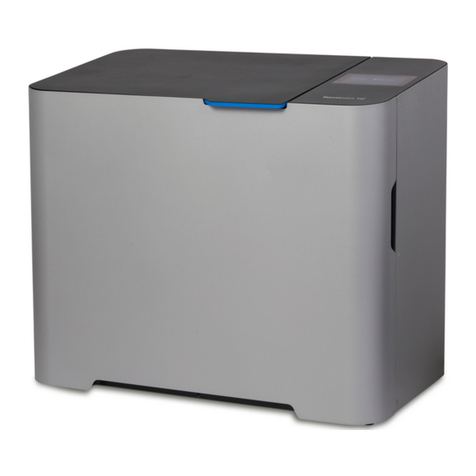
formlabs
formlabs Form Wash L User manual
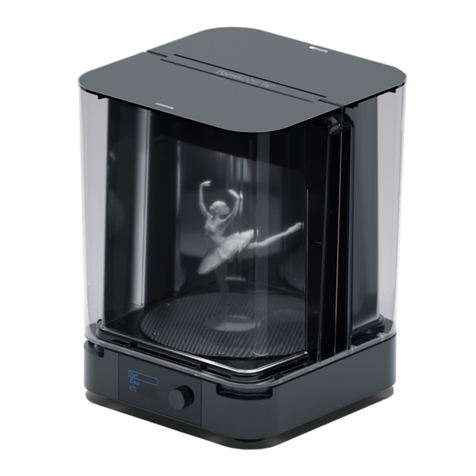
formlabs
formlabs Form Cure User manual
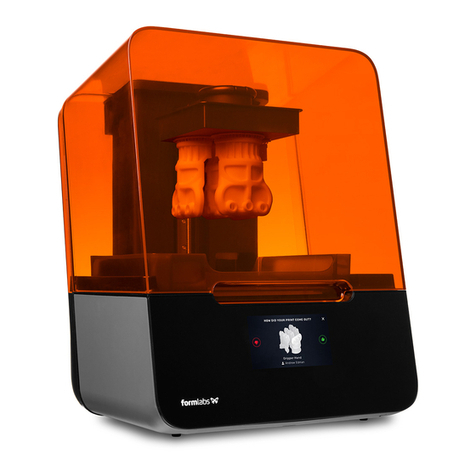
formlabs
formlabs Form 3 User manual
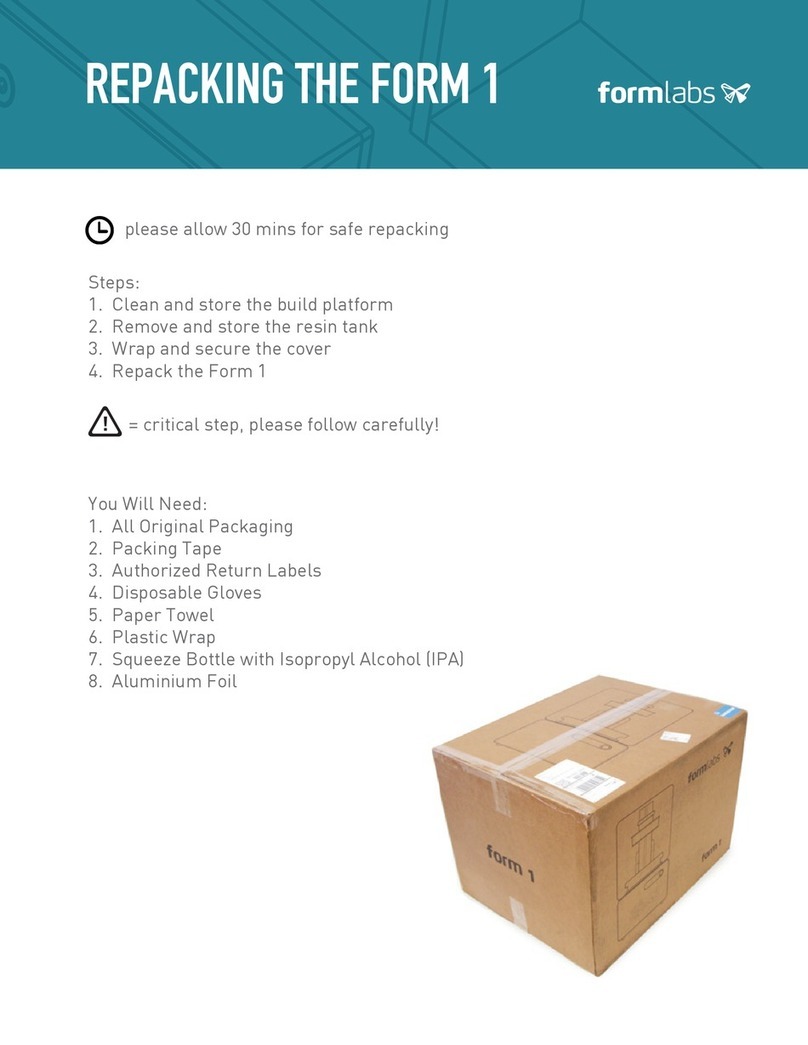
formlabs
formlabs FORM 1 User manual
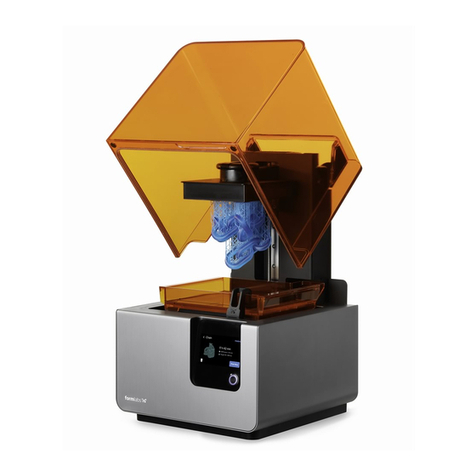
formlabs
formlabs Form 2 User manual

formlabs
formlabs Form 3 User manual

formlabs
formlabs Form 2 User manual
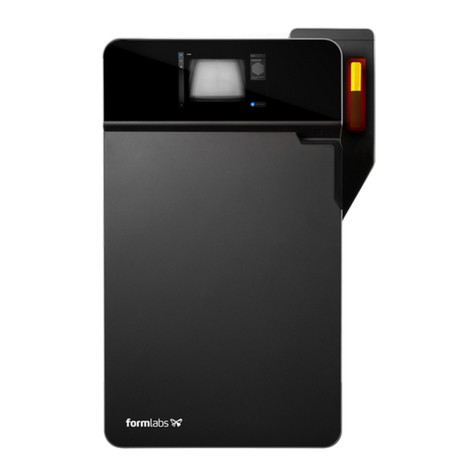
formlabs
formlabs Fuse 1 User manual
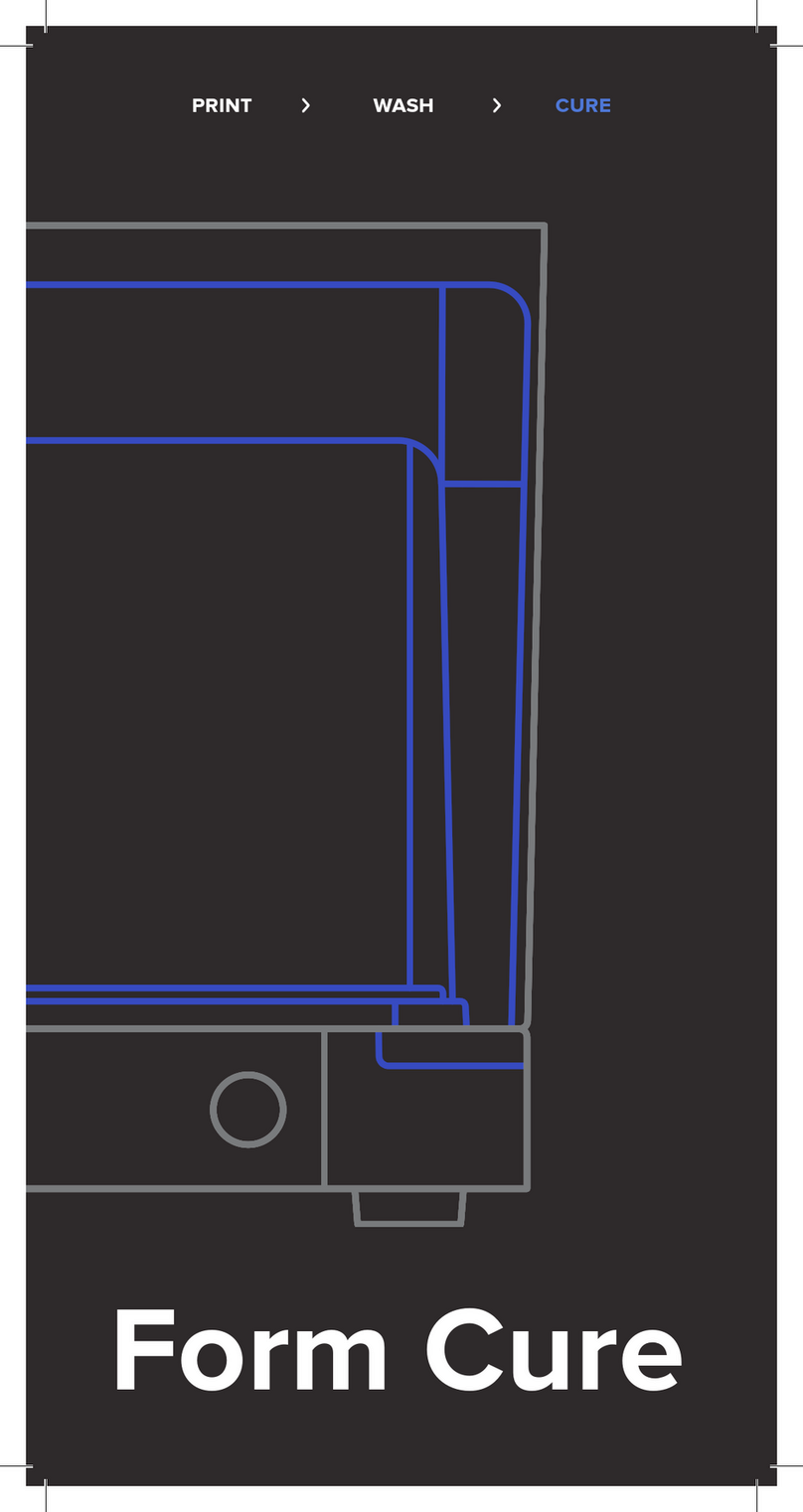
formlabs
formlabs Form Cure User manual
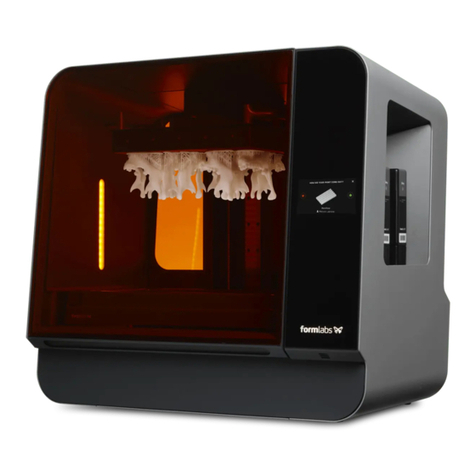
formlabs
formlabs Form 3BL User manual

